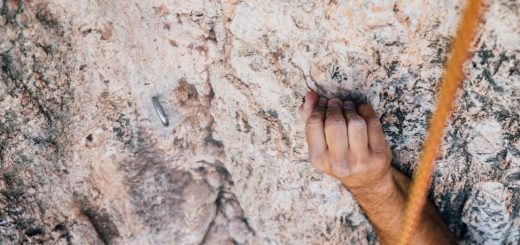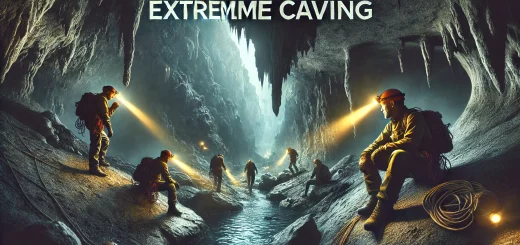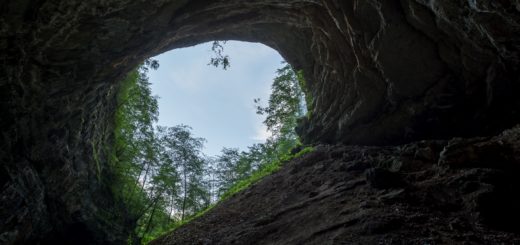Cave Diving – How It All Started
Cave diving is, without doubt, the most dangerous and probably the most rewarding aspect of caving. Within limits, all dry caves are accessible to the normally equipped caver but the ultimate in exploration lies in those depths which are completely submerged. Water, the sculptural force in most limestone caves, was often the barrier to exploration even in the simplest and shortest of sumps. ‘What lies on the other side?’ was a question which was not answered until well into our present century.
The advice of Henry Mayhew in Punch magazine in 1845 to those about to marry ‘Don’t’ is equally applicable to those who want to take up cave diving. It demands the highest mental and physical discipline because of the hazards and, at times, almost complete self-dependence. It is simply not enough to be a competent underwater swimmer or snorkel diver for, even with the most modern equipment, emergencies arise in cave waters which are special to their locale.
Today’s modern equipment, of course, bears little resemblance to the primitive tackle first used so long ago when air was pumped manually to a diver. Little was known then of the effects of water pressure, the complications of decompression arising from too rapid an ascent from considerable depths and other physiological problems. That brilliant cave diver and poet of the depths, my friend Mike Boon, now nourishing in Canada, laconically described cave diving as ‘bloody hazardous, by a factor of many’, and he should know. The first recorded dive with equipment the diver being Ottonelli of Marseille backed up by the engineer Maurius Bouvier was on 27 March 1878 in the Fontaine-de-Vaucluse. Air was pumped to the brave Ottonelli and he got down about 75 feet (23 metres) before being forced to give up the attempt, it was sixty years before another attempt was made at the same spot.
In caving, it has always been known that diving, in one form or another, was the only way to solve some of the ultimate cave problems of this century. Exploration ceased where rock and water met at a sump. Early explorers were forced to stop at such obstacles but there were some, the foolhardy and the brave (they exist even today!) who forced themselves to the limits of human endurance to get through on sheer lung power alone. The first lung-power dive in Britain seems to have been undertaken by an anonymous adventurer mentioned in William Bray’s written account of his historical tour of Derbyshire; possibly inspired by stronger waters than those from the local springs, he tried to swim through the ‘River Styx’ at the Buxton Water rising in Peak Cavern, Castleton. His dive into the sump came to an abrupt end when he banged his head on a rock and sank senseless to the bottom. He was rescued alive, with difficulty. This sump did not give up its secrets until 1949 when the Derbyshire section of the Cave Diving Group, using adapted wartime frogmen’s suits, got through a totally submerged passage to arrive at a ‘Torricellian chamber’ (in effect an airbell or vacuum completely sealed off in the rock by the surrounding water). Derbyshire still holds an important place in British cave diving.
The first great breakthrough in cave diving, which showed what could be done on lung power alone, coupled with courage, confidence and superb training, was Norbert Casteret’s penetration of the Montespan Grotto in the Haute-Garonne in August 1922. When I met him on a rare visit to Britain a few years ago, he told me it was one of the hardest things he had ever undertaken but he was sustained by a firm conviction that, though trés difficile, he would get through. In his own words, he decided to ‘dare the underground river and push into the bowels of the mountain.’ He made the dive naked, carrying his matches and candles wrapped in his rubber diving helmet, to keep them dry. He dived into the siphon and pressed on. Even he, with his vast experience and psychological balance, became aware of the oppressive loneliness and isolation of his position, aware that staying alive depended on keeping his few matches dry. A year later, he and Henri Godin, in slightly drier conditions, were able to proceed further to discover what many cave divers dream about, a huge treasure house of rock engravings, clay statues and other prehistoric remains. This dive encouraged others to re-think about the psychological barriers to their own explorations and more determined efforts were made to get through hitherto hopeless sumps. The alternative method of getting through was to pump or bail these siphons dry or, where possible, build dams and divert the waters elsewhere to clear an air space.
All early attempts at diving with equipment to sustain life were handicapped by the cumbersome nature of the equipment and the problems of maintaining the supply of air. As far back as the 18603, the French engineers Rouquayrol and Denarouze produced a regulator which allowed air to be breathed under water. Their Aerophore was a strange contraption from which the diver drew air from a heavy cylinder but, as there was no means in those days of applying compression, the supply to the cylinder had to be kept constant by an air line. The system was abandoned but the theory made a dramatic re-emergence eighty years later. The traditional diving gear was a thick rubber suit in which it was difficult to manoeuvre, a copper helmet clamped to it and to which air was pumped, and lead weighted boots which further restricted mobility. Cave diving in such equipment was almost out of the question and such dives as were made could only be in wide, open passages.
Courageous free-divers, using lung power alone, made heroic efforts to extend cave limits. One of the most outstanding in this country was Bob Leakey’s dive, naked a la Casteret in Disappointment For in January 1944. This added considerable knowledge about the Gaping Gill system, solving the problem of where the waterfall came from at the end of Hensler’s Passage and completing the circuit between Disappointment Pot and Gaping Gill Main Chamber. But cavers have always been inventive and several, who formed the first cave diving groups, struggled to find ways of overcoming the sump problem, tantalised by the knowledge that once through the water trap, there were great areas of potential exploration. F. Grahame Balcombe and his friend Jack Sheppard, both members of the Northern Cave and Fell Club, could be said to be the founding fathers of British cave diving. Although northerners who first became interested in the Pennine systems, they became fascinated with the caves and potholes of the Mendip Hills and the birthplace of British cave diving was the famous Swildon’s Hole.
The first sump (it was obviously the only one at the time) was a frustrating block to the determined efforts of Mendip cavers. In February 1934 Balcombe and Sheppard and a few others planned a campaign. Preliminary blasting had proved abortive and some way of diving had to be found. A senior engineer with the Post Office at that time, Balcombe was of an inventive turn of mind as well as a dedicated caver. He devised a diving kit which seemed inspired by the absurd ingenuity of Heath Robinson. It involved part of a bicycle frame, two valves for the intake and outlet of air, which was supplied through a 40 foot(12 metre) length of garden hose and conventional swimming goggles. It was with some trepidation that Balcombe took the first plunge and almost immediately became involved in what has always been an inhibiting factor in many water passages, the loss of visibility due to churned up mud. He was completely unnerved when he found he could not see and retreated. Sheppard fared no better. The hosepipe air line fell off as he was submerged in the passage and he got back to safety only with difficulty.
Although these two small dives were unsuccessful, sufficient was learnt to encourage further attempts with improved equipment. Further blasting, some of which is said to have elevated a Sunday congregation in Priddy church from their seats, did not improve matters and diving was resorted to, once again, in October I936. This time Sheppard had a new outfit which provided some protection from the water, and the air came to him from a new, light-weight pump. By synchronising his breathing with that of the pumping. he ventured into the unknown and succeeded in getting through the siphon. He found, as other equipment divers have later revealed, that the intimidating sumps could he dived free, which Balcombe subsequently did. The way was known to be safe for a short, sharp dive. For a long time it was accepted as gospel truth that the 2 foot (60 cm) high passage was 10 feet (3 metres) long. But over thirty years later a more
scientific measurement was made by the Simple expedient of passing a tape measure through the passage and the obstacle which so daunted the explorers was found to be (according to the records of the University of Bristol Spelaeological Group) a mere 34 inches (86 cm). Time and nature may have changed the length of the sump in the intervening years and, in mentioning it, it is by no means my intention to belittle this plunge into the unknown. The people who dived Swildon’s were the forerunners of that elite band who now form our national body, The Cave Diving Group, founded in 1946. Cave diving received considerable impetus and encouragement from the kindly and professional interest of Sir Robert Davies of the famous diving and engineering safety firm of Siebe, Gorman & Co. who was delighted with the honour of being the CDG’s first honorary president. With his support and improved equipment, attention was turned to Wookey Hole and the underground passage of the river Axe which emerges in what is known as ‘Britain’s oldest stately home’, insofar as it provided shelter for our early forefathers.
Apart from the assistance from improved equipment, Wookey had the advantage of mainly clear water, unsullied by the thick brown mud usually found. In one of the most lyrical of caving descriptions, Penelope Powell, one of our first woman cavers and probably the first woman cave diver wrote: ‘. . . slipping down from the enveloping brown atmosphere, we suddenly entered an utterly different world, a world of green, Where the water was clear as crystal. Imagine a green jelly, where even the shadows cast by the pale green boulders are green but of deeper hue; as we advanced, light green mud rose knee-high and fell softly and gently into the profound greenness behind. So still, so silent, unmarked by the foot of man since the river came into being, awe-inspiring though not terrifying, it was like being in some mighty and invisible presence, whose only indication was this saturating greenness.’ Meanwhile, about the same time, interest was growing in underwater swimming and the largely unexplored world under the sea.
In the years before the last war, swimmers began to fix fins or flippers to their feet, while goggles and face masks allowed brief but clear glimpses of the sub-aqua world. The now legendary Jacques Cousteau was at the beginning of his long love affair with the depths and resented the restrictions imposed by pumped-air systems. About the time of the Swildon’s Hole dive, Commander Le I’rieur of the French navy designed a self-contained diving kit using Compressed air in a portable cylinder and a face mask. Cousteau experimented with hand-pumped air lines and an oxygen re-breathing set which he had worked on with Frederic Dumas. The air line had its inherent limitations on distance and mobility and the oxygen set nearly proved fatal.
The demands of war led to many developments in underwater movement. Dunlops and their special projects general manager Wally Graham evolved the skin-tight, dry diving suit at the instigation of Major ‘Blondie’ Hasler of the Combined Operations Development Centre. Hasler’s exploits with his canoe team in raids on enemy shipping are well known. As this type of warfare advanced, Hasler became dissatisfied with the method of attaching limpet mines to enemy ships by means of long poles. He said his men could do a better job if they could get right under the ships and this required a light and flexible skin suit. It is a remarkable tribute to Graham that the original design has changed little in the past thirty years apart from the switch to the new synthetic rubber materials like neoprene.
As cave diving resumed after the war, divers first used the old closed-circuit re-breathing equipment in which, it was found, the disadvantages outweighed the advantages of its use. In use, it required oxygen cylinders or bottles as they are now known a breathing bag on the chest and the use of soda lime to absorb the exhaled carbon dioxide. The greatest disadvantage in the use of oxygen is the poisoning it engenders in the blood and the brain. I will refer to this later.


